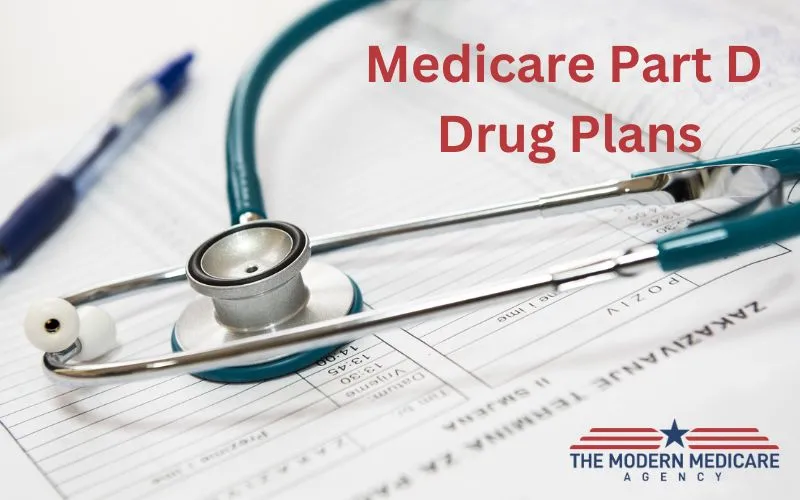Original Medicare leaves several gaps in healthcare coverage. One of the main gaps is that it doesn’t include most outpatient prescription drugs, meaning that you could end up footing the costs. The best way to solve the problem is to buy a stand-alone Part D Plan (PDP) or get a Medicare Advantage plan with prescription coverage.
Since the correct medical and drug coverage provides you with more peace of mind, let’s take a closer look at Part D Drug plans with answers to all your questions.
What You Must Know About Medicare Part D Drug Plans
Medicare Part D Plans bought through private companies form part of a federal program to provide drug coverage to Medicare consumers.
What options do you have for prescription drug coverage?
There are two options for getting coverage for your prescription drugs when you are with Medicare. Both options are available from most private insurers:
- Your first option is a Medicare Prescription Drug Plan (Part D), also known as PDP. These stand-alone plans add drug coverage to Original Medicare. They also add them to some Medicare Cost Plans, some Medicare Private Fee-for-Service (PFFS) Plans, and Medicare Medical Savings Account Plans (MSA).
- Your second option is to buy a Medicare Advantage Plan (Part C), like an HMO or PPO. You can also buy other Medicare health plans offering Medicare prescription drug coverage. With this option, you get all the Medicare Part A (Hospital Insurance) and Medicare Part B (Medical Insurance) coverage, to which the insurer adds prescription drug coverage (Part D). However, you must have Part A and Part B Medicare to join a Medicare Advantage Plan. Medicare Advantage Plans are also known as MA-PDs.
Where can I buy Medicare Part D Plans?
You can get a Medicare Part D Plan through almost all private carriers in the same way you can get Medicare Supplements and Medicare Advantage Plans. Some examples of private carriers include Blue Cross, Cigna, Aetna, United Health Care, etc.
Are all the Medicare Part D Plans the same?
All Medicare Part D Plans must meet specific requirements, following a model set by Medicare. However, they don’t always have the same formulary because they can change their plans to make them more attractive to certain people. Therefore, a carrier may even change its formulary annually.
Additionally, these plans can also have different deductibles or copays.
Where can I compare Medicare Part D plans?
You can start your research on Medicare.gov, where you can see the carriers with the most reduced costs with the most out-of-pocket expenses (including premiums plus copays). These are in order from one to ten. However, when comparing the plans, it’s essential to compare the cost savings and the formulary to ensure that you benefit as fully as possible.
You can also get help with your comparisons and get a quote for a Part D drug coverage plan from the team at The Modern Medicare Agency.
As a couple, can we have two separate Medicare Part D Drug Plans?
Yes, you can and many times should have two separate Medicare Part Drug Plans if you are a couple. That way, you can get the most coverage for less.
What will a Part D Drug Plan cover?
Since all Part D Plans follow Medicare guidance, the plans are similar. However, besides having four phases of coverage, insurers also place the drugs in tiers where you pay a different cost-sharing once you have met the deductible amount.
For example, tiers one and two common and generic drugs have low or no copay and they don\’t apply to the deductible in most plans. However, tier three and up drugs have different cost-sharing that depends on the value of the drugs.
Phase 1 is the deductible phase. Depending on what tier your drugs are, you may have to meet a plan deductible. Once you have reached the deductible, your insurer covers a certain amount, and you either pay a copay or coinsurance according to your plan. Some are zero dollars, but they may not exceed $505 in 2023. Most plans don’t apply the deductible to generics during this phase for tier one and two drugs.
Phase 2, or the initial coverage phase, is when the plan starts its predetermined sharing of prescription costs with you as a copayment or coinsurance. For 2023, the coverage phase ends when your total drug cost (your out-of-pocket and plan pay) is $4,660.
Phase 3, known as the coverage gap or Donut Hole, you receive a 75% discount on all covered drugs, with you paying 25%. For 2023, the set out-of-pocket limit stands at $7,400.
Phase 4, often called the catastrophic coverage phase, is when your plan covers most of the costs for your prescription drugs. During this phase, you pay $4.15 per month for generics or $10.35 for name-brand prescriptions, or 5% of the medication’s retail cost, whichever cost is higher.
Fortunately, most people on Medicare never leave phase two because it can become quite expensive.
How can you stay out of the coverage gap?
Ask your doctors about taking generic options whenever possible to stay out of the coverage gap. Many drug manufacturers also offer prescription assistance for many of their expensive drugs. In addition, some states have off-state pharmaceutical assistance programs helping with costs.
Do all Medicare Part D Plans have deductibles?
A Medicare Part D deductible or limit is the amount you must pay annually before your plan begins to pay. Medicare requires that Medicare Part D deductibles cannot exceed $505 in 2023, but they can have deductibles lower than this. In addition, some Medicare Part D plans don’t have deductibles.
Additional Reading: The Medicare 8-Minute Rule
Final Take
Since everyone’s prescription drug needs differ, leave the daunting task of finding the best Medicare Part D Drug Plan coverage for you to the experts at the Modern Medicare Agency. Contact us for assistance from a personalized broker from our team of experts who will help you find the providers with the best prescription drug plans.






